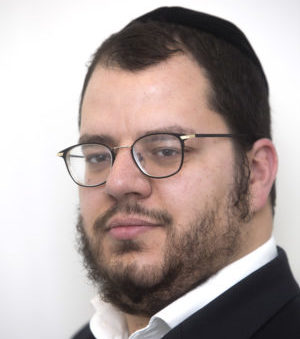Torah of a Niggun

It’s a chassidus best known for its stirring melodies, but those tunes were the souls of the rebbes who wrote them.

The few hundred men fortunate to be at the Emunas Yisrael beis medrash in Boro Park the first night of Chanukah two years ago were treated to a Heavenly chariot ride: a classic Modzhitz lichttsinden. The Modzhitzer Rebbe of Bnei Brak — a guest of his dear friend, Emunas Yisrael mashpia Rav Moshe Wolfson — was joined by world-renowned Modzhitz composer and chazzan Rabbi Benzion Shenker for an hour of transformation: spiritual intensity joined with the power of niggun so typical of this chassidus. For Reb Benzion (then 88), it was one more adventure in the 70-plus years at the side of Modzhitzer rebbes; for the Rebbe, it was another expression of his link in a dynasty that has elevated the power of melody to a level of meditation and purification.
The Rebbe — Rav Chaim Shaul Taub — has led the chassidus for the past decade with a combination of his Ponevezh-trained, brilliant analytical mind and the heart of a Modzhitz niggun; now it’s Chanukah again, and within Modzhitz’s special Maoz Tzur, I can still hear the Rebbe’s Selichos of three months ago — it is said that the last day of Chanukah is the final reprieve for the judgment of Rosh Hashanah. Perhaps that’s why there is no derashah before Selichos in Modzhitz, none of the customary words of inspiration and introspection, no mussar seder.
“In Modzhitz,” an elderly chassid told me before Selichos in the Bnei Brak beis medrash (where the chassidus was transplanted 20 years ago after five decades in Tel Aviv), “hearing the Rebbe reciting ‘Ashrei yoshvei veisecha’ is enough to stir our hearts to teshuvah.” Minutes later, as I watched the leader of this holy flock pouring out words of the tefillos, it seemed as if the entire Modzhitzer shul had been transformed into a solid block of kedushah.
In Modzhitz, the chassidim tremble in fear of Heaven like everyone else, but here, it’s accompanied by song. Here, pious Jews — chassidim in spodeks and clean-shaven Litvaks in Borsalinos — give expression to that awe through niggunim crafted by the tzaddikim of the dynasty, from the first Modzhitzer Rebbe, Rav Yisrael Taub, to the current Rebbe — a venerated rosh yeshivah and also a mechaber of song in his own right.
It’s All Hefker
It would be difficult to imagine the world of chassidic music without Modzhitz. The founder of the Modzhitz dynasty, Rebbe Yisrael Taub of Modzhitz (known as the Divrei Yisrael), once commented, “People say that the world of music is closely connected to the world of teshuvah — but I say that they are one and the same.”
The Divrei Yisrael, who passed away in Kislev 1920, was known for his piety, his Torah knowledge, but especially for his musical prowess. He composed hundreds of niggunim, but the story of his most famous niggun, “Ezkera,” has become legend within the chassidus. It was composed in 1910 when the Rebbe — who was diabetic and had terrible sores on his feet — was sent to Karlsbad for the healing baths. Looking around at the beauty of the resort and thinking of Jerusalem in ruins, he created a niggun to the words from Ne’ilah: “Ezkera Elokim v’ehemaya… I remember Hashem and I groan, as I see every city built to beautiful great heights, but the city of Hashem has been relegated to the depths of purgatory…”
After many unsuccessful healing attempts, one of his feet became so infected that the Rebbe developed gangrene and the doctors determined that his leg had to be amputated to save his life. The Rebbe traveled to Berlin for the surgery, but because of his weak heart, it was impossible to anesthesize him. Throughout the excruciating surgery and recovery, the Rebbe entranced himself with various niggunim, and turning his head toward the window where he could see the vista of the city, he chanted “Ezkera.” The complicated composition — which takes over 20 minutes to sing — is carefully guarded by the chassidim and only sung on special occasions. Today the only way to hear “Ezkera” is to attend a yahrtzeit seudah for the Divrei Yisrael on 13 Kislev in a Modzhitz beis medrash — yet hundreds of other Modzhitz niggunim have made their way into the classic chassidic repertoire.
Oops! We could not locate your form.






